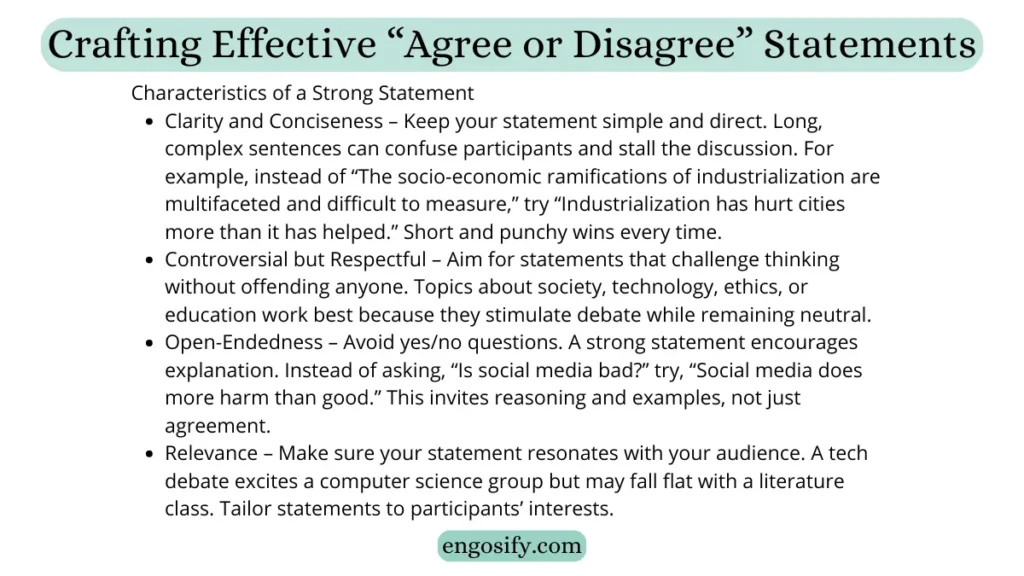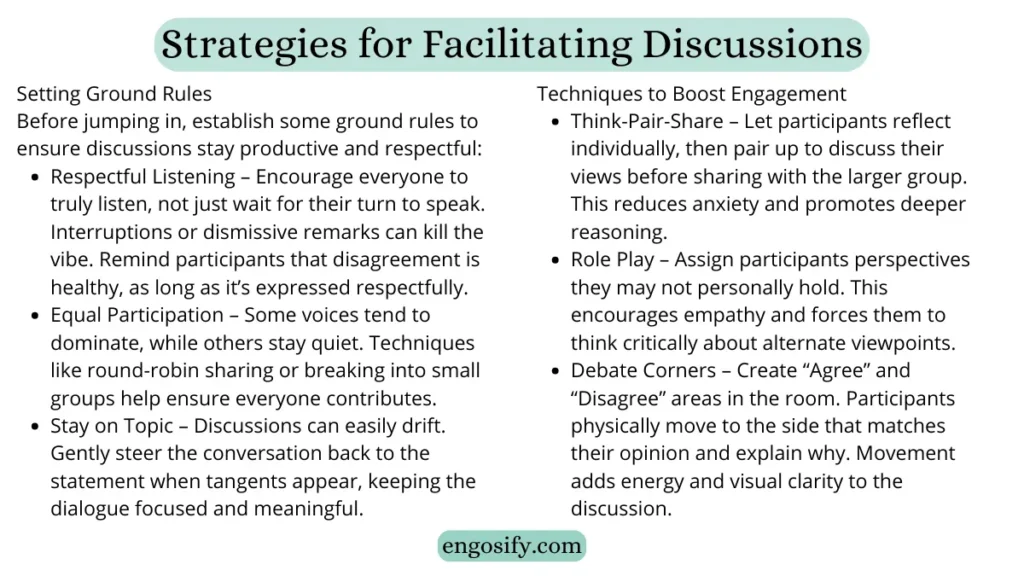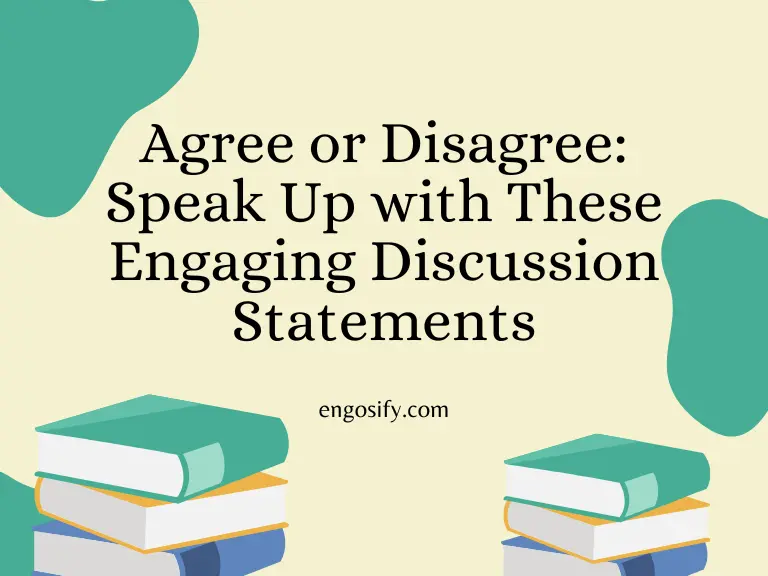Ever been in a conversation where everyone nods politely but nobody really speaks up? Yeah, we’ve all been there. That’s exactly where “Agree or Disagree” statements shine—they’re like conversation sparks that ignite debate, challenge thinking, and get everyone talking. Whether you’re in a classroom, a workshop, or just chilling with friends, these statements push people to express opinions, defend ideas, and even reconsider their perspectives. In this article, we’ll dive into why these statements work, how to craft them, categories to explore, strategies to facilitate lively discussions, and the benefits they bring to communication and critical thinking. Ready? Let’s jump in.
Introduction
What Are “Agree or Disagree” Statements?
“Agree or Disagree” statements are simple yet powerful tools designed to get people thinking critically and talking openly. Essentially, they are declarative sentences that invite participants to take a stand—agree, disagree, or somewhere in between—and explain their reasoning. These statements aren’t just idle chatter; they serve as a springboard for dialogue, reflection, and learning. By presenting ideas that spark curiosity or mild controversy, they encourage participants to articulate their viewpoints clearly, listen attentively, and engage in meaningful discussion.
In classrooms, workshops, or discussion groups, these statements can be game-changers. They allow for thoughtful debates, help uncover diverse perspectives, and cultivate a space where every voice matters. Beyond just learning facts or information, participants practice reasoning, empathy, and persuasive communication—skills that are crucial in today’s fast-paced world.
Why Use Them in Discussions?
Using “Agree or Disagree” statements comes with a ton of perks. For starters, they instantly boost engagement, transforming passive listeners into active contributors. People are naturally wired to defend or challenge ideas, and these statements tap into that instinct, making conversations lively and memorable.
Moreover, they enhance critical thinking, forcing participants to analyze information, weigh pros and cons, and justify their stance. This isn’t just about debating for the sake of arguing—it’s about developing sharper reasoning skills and fostering an environment where diverse opinions are not just tolerated but celebrated.
For educators looking to spice up classroom discussions, these statements are a must-have tool. You can explore effective strategies for class discussions to make sure every student has the confidence and opportunity to speak up.
Crafting Effective “Agree or Disagree” Statements
Characteristics of a Good Statement
Crafting effective “Agree or Disagree” statements isn’t rocket science, but it does require a bit of finesse. The goal is to spark conversation without confusing or alienating your audience. Here are the golden rules to follow:
- Clarity and Conciseness – Keep it simple, snappy, and easy to grasp. Long-winded or complex statements tend to lose people, and suddenly, the discussion stalls. Think short, punchy, and direct. For instance, instead of saying, “The socio-economic ramifications of industrialization on contemporary urban planning have a multifaceted impact that is difficult to quantify,” try something like, “Industrialization has hurt cities more than it has helped.” Much cleaner, right?
- Controversial Yet Respectful – You want your statements to get people talking, not fighting. The sweet spot is presenting ideas that are thought-provoking but don’t attack anyone personally. Statements about societal trends, technology, education, or ethics work wonders here.
- Open-Endedness – Avoid statements that lead to a simple yes/no answer. You want participants to explain why they agree or disagree. For example, instead of saying, “Is social media bad?” try, “Social media does more harm than good.” Boom—now you have a discussion starter that invites reasoning, examples, and stories.
- Relevance – Make sure the statement resonates with your audience. Context matters! A discussion about AI replacing jobs is thrilling for a tech-savvy group but might fall flat in a history club. Tailor your statements to the interests and knowledge of your participants.

Examples of Well-Crafted Statements
Let’s make it concrete. Here are some sample statements you can use to ignite debate:
- “Homework does more harm than good in schools.”
- “Technology isolates people more than it connects them.”
- “Grades are not an accurate measure of a student’s ability.”
- “Climate change is the most urgent problem facing humanity today.”
- “Success is more about luck than hard work.”
These examples are short, bold, and invite critical thinking and discussion. The magic is in how you phrase them—they’re straightforward but open-ended enough for participants to expand, challenge, and defend their views.
For those seeking inspiration or a ready-to-use list of topics, platforms like EnglishClub’s debate topics provide hundreds of ideas to keep your discussions fresh and engaging.
Categories of Discussion Statements
When it comes to “Agree or Disagree” statements, variety is key. Choosing different categories keeps the conversation fresh, sparks diverse viewpoints, and ensures everyone finds something they can relate to. Let’s explore the main categories and examples that consistently ignite engaging discussions.
1. Social Issues
Social issues are a goldmine for discussion because they touch on everyday life and evoke strong opinions. From gender equality to social media influence, these topics make people think critically about society and their own beliefs.
Examples:
- “Social media does more harm than good.”
- “Teenagers spend too much time online.”
- “Volunteering should be mandatory for all students.”
Discussion Points:
- How technology affects relationships and mental health
- Privacy concerns in a digital world
- The value and impact of community service
Engaging students or participants in these topics encourages them to connect current events with personal experiences, making the conversation lively and relatable.
2. Education
Education statements are perfect for classrooms, training sessions, or academic workshops. They challenge conventional wisdom and encourage participants to reflect on how learning systems work.
Examples:
- “Standardized testing is an accurate measure of student ability.”
- “Homework does more harm than good.”
- “Learning should be more practical than theoretical.”
Discussion Points:
- Fairness of exams and grades
- Stress and mental health impacts on students
- Alternative methods for assessing learning
Using these statements can transform a standard classroom into an interactive discussion hub. You can even check out EducationWorld’s discussion tips for techniques that make debates more structured and engaging.
3. Technology
Technology topics always get people talking because the world is changing fast. Participants often have strong opinions about how gadgets, AI, and digital platforms affect life.
Examples:
- “Artificial intelligence will replace most human jobs.”
- “Smartphones have improved our lives more than harmed them.”
- “Video games are a waste of time for teenagers.”
Discussion Points:
- Job displacement and automation
- Ethics of AI and surveillance
- Balancing screen time with real-life interaction
These statements not only stimulate debate but also encourage participants to consider future implications, making the discussion forward-thinking and thought-provoking.
4. Environment
Environmental statements resonate because climate change, pollution, and sustainability affect everyone. These topics often blend facts with personal responsibility, sparking passionate debates.
Examples:
- “Climate change is the most pressing issue of our time.”
- “Individual actions cannot make a difference in protecting the environment.”
- “Renewable energy should replace all fossil fuels immediately.”
Discussion Points:
- Global warming and its local impacts
- How personal habits contribute to environmental problems
- Policy changes vs. individual responsibility
Environmental debates also teach critical thinking and the importance of evidence-based arguments, especially when participants must defend or challenge scientific data.
5. Ethics and Morality
Ethical statements invite participants to wrestle with dilemmas and reflect on their values. These discussions encourage empathy, reasoning, and sometimes, a little soul-searching.
Examples:
- “The end justifies the means.”
- “Lying is acceptable if it helps someone.”
- “Animals deserve the same rights as humans.”
Discussion Points:
- Moral reasoning and ethical principles
- The grey areas between right and wrong
- Respecting different cultural or personal beliefs
These statements are excellent for workshops, classrooms, or any setting where deep reflection and conversation are encouraged. If you want practical ways to facilitate these discussions, Powerful Panels’ interactive discussion techniques are a great resource.
Strategies for Facilitating Discussions
Even the best “Agree or Disagree” statements can fall flat without the right strategies to guide the conversation. Facilitating discussions is both an art and a science—it’s about creating a safe space, encouraging participation, and keeping the dialogue lively. Let’s explore proven strategies that make discussions engaging and meaningful.
Setting Ground Rules
Before diving into debates, it’s crucial to set some ground rules. This helps maintain respect, clarity, and focus throughout the discussion.
- Respectful Listening – Encourage participants to truly listen to each other. Interruptions, sarcasm, or dismissive comments can kill engagement. A good facilitator reminds everyone that even disagreement is an opportunity to learn and understand.
- Equal Participation – Some voices dominate while others stay silent. To avoid this, use techniques like round-robin sharing or small group discussions. Everyone should feel comfortable expressing their thoughts without fear of judgment.
- Stay on Topic – It’s easy for debates to drift. Keep the discussion focused by gently steering participants back to the statement, especially if tangents arise.
By establishing these ground rules early, you create a respectful and productive discussion environment that encourages critical thinking and active participation.
Techniques to Enhance Engagement
There are several creative ways to energize discussions and make them more interactive:
- Think-Pair-Share – Give participants a moment to reflect individually, then pair them up to discuss their views before sharing with the larger group. This reduces anxiety and promotes deeper reasoning.
- Role Play – Assign participants perspectives they may not personally hold. This encourages empathy and forces them to think critically about alternate viewpoints.
- Debate Corners – Set up “Agree” and “Disagree” areas in the room. Participants physically move to the side that matches their opinion, then explain their reasoning. Movement adds energy and visual clarity to discussions.
- Prompt Follow-Up Questions – Use probing questions like, “Why do you feel that way?” or “Can anyone think of an exception?” This encourages participants to provide examples and justify their stance, keeping the conversation alive.

Managing Disagreements
Disagreements are inevitable—and actually a good thing! They show engagement and differing perspectives, but they must be managed effectively:
- Stay Calm – As a facilitator, model composure and diplomacy. Participants often mirror your behavior.
- Seek Common Ground – Even in heated debates, highlight areas where opinions overlap. This reduces tension and fosters collaboration.
- Encourage Evidence-Based Arguments – Asking participants to back up claims with facts or examples promotes critical thinking and prevents arguments from becoming personal attacks.
Using these strategies not only makes discussions more productive but also helps participants develop communication skills that extend beyond the conversation. For more tips on handling disagreements and fostering respectful dialogue, WSJ offers practical guidance.
Benefits of Using “Agree or Disagree” Statements
Using “Agree or Disagree” statements isn’t just about filling time with chatter—these statements pack a punch when it comes to developing skills and fostering meaningful dialogue. Let’s break down the main benefits.
Enhancing Critical Thinking
First and foremost, these statements boost critical thinking. When participants are asked to take a stance, they can’t just rely on gut feelings—they need to analyze the statement, weigh evidence, and consider alternative viewpoints. This process sharpens analytical skills, encourages problem-solving, and helps participants see situations from multiple angles. Over time, it strengthens the ability to think deeply and reason logically.
Improving Communication Skills
Another major perk is the improvement of communication skills. Agreeing or disagreeing effectively isn’t just about stating your opinion—it’s about articulating it clearly, backing it up with reasoning, and listening to counterarguments. This kind of practice helps participants build confidence in speaking, improves vocabulary, and promotes clarity of thought.
Promoting Open-Mindedness
Perhaps the most subtle but powerful benefit is fostering open-mindedness. When participants encounter perspectives that differ from their own, they’re encouraged to consider alternative viewpoints and understand the rationale behind them. This develops empathy, reduces bias, and encourages respectful dialogue.
For anyone looking to expand these skills further, online tools like GoRetro’s agree or disagree questions offer structured exercises to practice discussion statements, making it easier to incorporate them in educational or team settings.
FAQs
In any discussion about “Agree or Disagree” statements, questions naturally pop up. Let’s tackle the most common ones and give practical insights for using these statements effectively.
What Are Some Examples of “Agree or Disagree” Statements?
There’s no shortage of ideas! Some engaging examples include:
- “Homework does more harm than good.”
- “Technology isolates people more than it connects them.”
- “Climate change is the most urgent problem facing humanity today.”
- “Success is more about luck than hard work.”
These statements are short, clear, and invite participants to explain why they hold their views, making discussions lively and thoughtful. For a larger list, EnglishClub offers hundreds of debate topics that are perfect for classrooms or workshops.
How Can These Statements Be Used in Educational Settings?
Educators can use these statements in several ways:
- Classroom Debates – Assign statements to pairs or groups and have them present their arguments.
- Think-Pair-Share – Let students reflect individually, discuss in pairs, then share with the class.
- Warm-Up Activities – Start lessons with a statement to engage students and stimulate thinking.
These approaches make lessons interactive, encourage critical thinking, and ensure every student’s voice is heard.
Are There Any Online Tools to Create These Statements?
Yes! Several digital platforms generate or organize discussion prompts. Tools like GoRetro’s agree or disagree exercises or debate topic libraries help facilitators quickly find or customize statements suitable for any group, saving prep time while keeping discussions fresh and engaging.
Conclusion
“Agree or Disagree” statements are more than just conversation starters—they’re powerful tools for sparking critical thinking, enhancing communication skills, and fostering open-mindedness. By crafting clear, thought-provoking statements and using effective facilitation strategies, you can transform any discussion into a lively, engaging, and meaningful experience. Whether in classrooms, workshops, or casual group settings, these statements encourage participants to speak up, defend their viewpoints, and consider perspectives different from their own. So go ahead—embrace these statements, experiment with different categories, and watch your discussions come alive with energy, insight, and thoughtful dialogue.

